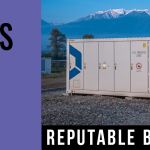 Although the technology was discovered at the beginning of the 20th century, the first lithium batteries didn’t make it to market until the 70s, and it was a series of breakthroughs in the early 80s that cemented it as the market leading product it is today.
Although the technology was discovered at the beginning of the 20th century, the first lithium batteries didn’t make it to market until the 70s, and it was a series of breakthroughs in the early 80s that cemented it as the market leading product it is today.
Lithium (and cobalt / graphite / nickel / manganese) cells replaced lead acid as the foremost battery chemistry simply because lithium has the lightest weight, highest voltage, and greatest energy density of all metals (why is a bubble round?); nevertheless, its relative scarcity and recent price escalation has some manufacturers shopping for alternatives.
The expansion of energy storage capacity is undoubtedly a societal necessity for the foreseeable future, but with extensive R&D in this area being a constant force for change, there is no reason to expect a single type of device to dominate the market indefinitely.
On March 7th, researchers at RMIT University in Australia announced that they had cracked a new type of battery chemistry that they have termed the “Proton Battery”, which rivals the current lithium-ion setup even before optimization.
The working prototype uses a carbon-based electrode to store hydrogen, coupled with a reversible fuel cell to produce electricity. The carbon in the electrode bonds with protons generated when charging by splitting water assisted by electrons from the power supply.
The protons are then released to pass back through the reversible fuel cell forming H2O with oxygen from the air to generate power. Lead researcher, Professor John Andrews, says it is the carbon electrode plus the protons from water that give this particular battery its environmental, technological and economic edge.
read more
 Nearly 50 public utilities have yet to account for the recent corporate income tax cut in their transmission rate formulas, and the Federal Energy Regulatory Commission wants to know why.
Nearly 50 public utilities have yet to account for the recent corporate income tax cut in their transmission rate formulas, and the Federal Energy Regulatory Commission wants to know why. Lithium, cobalt and nickel are experiencing price fluctuations as global tech and auto giants race to lock down these crucial battery materials.
Lithium, cobalt and nickel are experiencing price fluctuations as global tech and auto giants race to lock down these crucial battery materials. Energy storage is a tough concept to grasp. And until now, it’s been an even tougher technology to deploy. But the market for such technology is forecast to exceed the previous four years in this year alone because of falling prices and favorable policies.
Energy storage is a tough concept to grasp. And until now, it’s been an even tougher technology to deploy. But the market for such technology is forecast to exceed the previous four years in this year alone because of falling prices and favorable policies. The San Diego County Water Authority is
The San Diego County Water Authority is  On day one of
On day one of  The energy storage provider Blue Planet Energy recently deployed its Blue Ion energy storage systems to support the electrification efforts in Puerto Rico. These deployments took place in areas where there has not been reliable electricity since September of 2017, when Hurricane Maria struck. One site is a volunteer housing facility in the Isabela municipality and the other is located in the Corozal municipality to provide electricity to a clean water pumping system. Blue Planet Energy is also providing support through training and education sessions.
The energy storage provider Blue Planet Energy recently deployed its Blue Ion energy storage systems to support the electrification efforts in Puerto Rico. These deployments took place in areas where there has not been reliable electricity since September of 2017, when Hurricane Maria struck. One site is a volunteer housing facility in the Isabela municipality and the other is located in the Corozal municipality to provide electricity to a clean water pumping system. Blue Planet Energy is also providing support through training and education sessions. As the market for stationary storage grows, it is becoming more mobile. With the rental model that Younicos is introducing, a storage device can be put in place for a limited amount of time and moved when conditions change.
As the market for stationary storage grows, it is becoming more mobile. With the rental model that Younicos is introducing, a storage device can be put in place for a limited amount of time and moved when conditions change. PORTLAND, Ore., March 13, 2018 (GLOBE NEWSWIRE) —
PORTLAND, Ore., March 13, 2018 (GLOBE NEWSWIRE) — 



